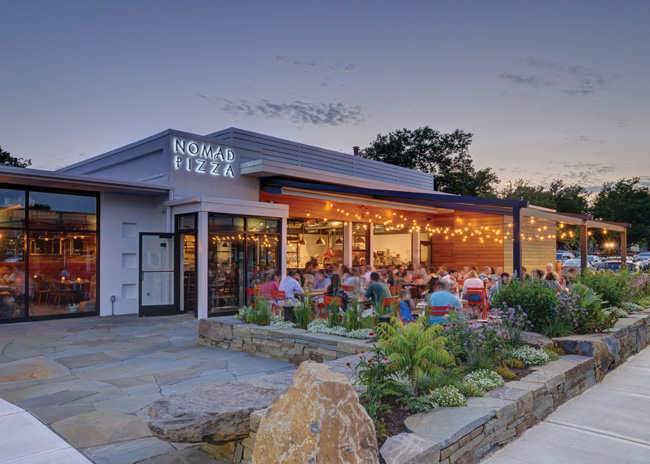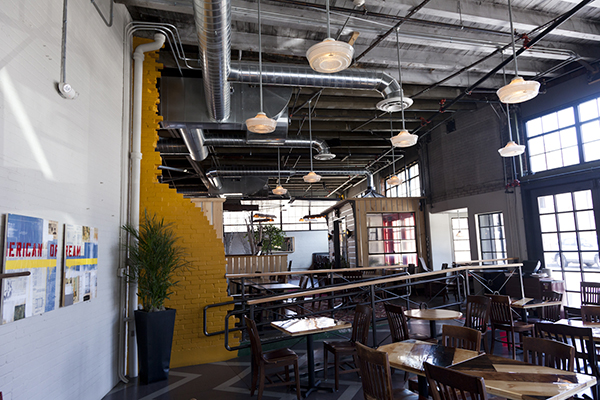Americans love pizza and pizzerias are ubiquitous, comprising 17% of all restaurants, according to The Pizza Calc.com. That amounts to more than 70,000 pizza-focused establishments. About 94% of Americans eat pizza regularly, with about 3 billion pies consumed domestically each year.
Pizza establishments range in size from small quick-service neighborhood joints where customers grab a slice or two, to full-service restaurants with large dining areas and extensive menus including a wide selection of non-pizza items. Large chains that achieve high service efficiency standards also occupy this space.
No matter the size or type, pizza restaurant designs must focus on essentials such as accommodating takeout and delivery, creating brand distinction, implementing efficient layout and optimizing service. In many designs, the anchor of the design strategy is the process of assembling and cooking the fare.
“A lot of times, clients want to show off the pizza-making process,” says Jessica Haley, principal and director of interior design, RODE Architects. “That often means an open kitchen.”
Indeed, kneading, stretching, and tossing dough; ladling of sauce; application of fresh ingredients; and placement and removal of pies in the oven is an eye-catching process. Higher-end establishments often show off the pizza-making process, and even some quick-service chains do the same.
“All of our stores are designed so that the makeline is transparent to the customer,” says Sean Keyes, VP of design and construction at Papa Johns. “This shows that our pizza is freshly made and made to order.” The open kitchen with ingredients easily visible also reflects Papa Johns motto: “Better ingredients, better pizza.”
“You can showcase ingredients like imported canned tomatoes and fine olive oil to highlight quality,” Haley says. Some clients stack bags of imported flour near the dough-making area to do the same, she says. Displaying all the elements of pizza-making requires considerable space, however. The dough-stretching station requires a generous counter area and a surface that aids preparation. “Some chefs like
Carrera marble for the counter,” Haley says. “It provides a cool surface that helps prevent dough from sticking to the surface versus a butcher block or a poly counter.”
 Papa Johns works to ensure customers can get a glimpse at the kitchen and the back of the house in order to show that their pies are made-to-order fresh. Image courtesy of Papa Johns
Papa Johns works to ensure customers can get a glimpse at the kitchen and the back of the house in order to show that their pies are made-to-order fresh. Image courtesy of Papa Johns
It’s important to allocate enough space around the oven for safe, efficient cooking. There should be at least a 5-foot-wide corridor of clear space, Haley says. Staff members use long-handled wooden paddles to insert and retrieve pizzas from the oven. “Like playing pool, you want enough space so that people are not poked with the handle,” Haley says.
The oven itself can be a focal point in a design. Some of Haley’s clients have chosen specialized gas pizza ovens imported from Italy that add aesthetic appeal. “You can put custom tile on them and a logo on them,” she says. “They become a hierarchical design element.”
Wood-fired ovens and the wood fuel they use also add visual appeal. Burning wood emits a warm glow that many patrons can see in an open kitchen setting. Wood storage adds aesthetic appeal with the natural fuel source on display. “Storage can be as simple as a timber rack like at a ski lodge,” says Joshua Zinder, principal and founder, Joshua Zinder Architecture & Design. Other wood storage options are simple wrought iron rails or tube steel holders.
“I have also used wood in taller, vertical elements as barriers in the dining room to create distinct spaces,” Haley says. “These stacks of wood are not accessed during service hours but are just for display.”
For the best visual appeal, Haley recommends displaying wood so that only the ends show. “It’s a nice, neat look,” she says. “If you show the wood from the side, it can look messy if you see splits and other flaws.”
 Mother Pizzeria’s imported gas pizza oven adds aesthetic focal point behind the counter. Image courtesy of Nat Rea Photography
Mother Pizzeria’s imported gas pizza oven adds aesthetic focal point behind the counter. Image courtesy of Nat Rea Photography
Using wood-fired ovens comes with complications, though. “Wood burning has different fire and life-safety considerations,” says Zinder. “You need a different flue type and exhaust as well as special approvals.”
Permitting varies by local jurisdiction but most add regulations for wood or charcoal-fired ovens. “In Boston, you need a special permit for wood burning,” Haley says. “That means it takes longer to get a project permitted than if you use a gas oven.” Boston also adds a requirement for an ongoing filter maintenance program as a condition of a wood burning permit. “Many operators prefer gas for its expedience and consistent temperature,” Zinder says.
Some pizza-focused establishments have an extensive bill of fare that can include pasta, charcuterie and other items. Haley cites a recent project in Newport, R.I., a venue called Mother Pizzeria, that wanted to appeal to both the hordes of summer tourists that flock to the ocean-side community and to year-round residents. The restaurant accommodates people throughout the day, offering Sicilian pizzas by the slice on display in a glass case, as well as appetizers, espresso, gelato and a bar. The venue has a casual side for customers wanting a quick snack or drink and a more formal space for those wanting a more extensive meal.
While the prep and baking process is often highlighted in pizza restaurant designs, other aspects of the kitchen are consigned behind walls to the back of the house. “The rest of the kitchen, such as prep and ware washing, is usually put behind the scenes,” Haley says.
Most pizza restaurants provide takeout and delivery service, in many cases its the lifeblood of the business. Hungry Howie’s, a 500-plus site chain, fulfills close to half of its orders via delivery drivers, and most of the balance of its sales occur via customer takeout. Hungry Howie’s strives to make third-party delivery drivers happy to take its orders.
“Door Dashers don’t like to wait in the lobby for five minutes or more,” says Steve Clough, director of development, Hungry Howie’s. “If you don’t treat drivers well, they will de-select you.” If a critical mass of drivers refuses to take your orders, patrons will have to wait longer for deliveries, degrading the customer experience. So, Hungry Howie’s emphasizes efficient order preparation and fulfilment in training and aims to always have orders ready when drivers arrive.
 Some pizza restaurants, such as Nomad Pizza, offer a large outdoor seating area as a distinguishing feature. Image by Michael Slack, courtesy of Joshua Zinder Architecture + Design
Some pizza restaurants, such as Nomad Pizza, offer a large outdoor seating area as a distinguishing feature. Image by Michael Slack, courtesy of Joshua Zinder Architecture + Design
Brands can expedite the pickup process for drivers by designating a pickup area specifically for deliveries. “We have two different lines — one for third parties, and one for customer pickup,” Clough says. “It can be as simple as putting a counter card up for third-party pickup.”
Many Hungry Howie’s locations have a drive-thru lane with a pickup window. The brand is working on a new prototype that may include two pickup windows with one dedicated to delivery drivers. Whether and how many locations might adopt that feature will partially depend on local permitting, as some jurisdictions may not allow two drive-thru windows for safety reasons. “In warmer climes, we may have a walk-up window for third parties,” Clough says. “It also depends on human resources in the store.” If having two separate windows strains staff functionality, one window may be the best option.
Some Papa Johns locations include pickup windows, but the brand doesn’t require them. “We can be flexible with our designs,” he says. If the location meets criteria indicating that it will support a thriving business, the brand is likely to open a store there even if the space isn’t at an end cap — a necessity for a pickup window. Sites lacking pickup windows typically have several dedicated parking spots for both drivers and to-go customers.
Quick-service chains such as Papa Johns and Hungry Howie’s that depend on takeout and delivery for the bulk of sales have small store footprints that help keep real estate costs down. Small footprints present design challenges, though. “Our lobbies are small — 100 square feet to 200 square feet, at most,” Clough says. High ceilings can help make the space seem bigger. “At a recent project in Traverse City, Michigan, we didn’t add a drop ceiling,” Clough says. “That really opened up the space.” Hungry Howie’s lobbies typically include either benches or small seats for customers to wait for their orders. Orders are made quickly, so waits are usually short.
 Mother Pizzeria has a somewhat formal dining room alongside a bar. The venue has a casual sit-down area in another room. Image by Nat Rea Photography
Mother Pizzeria has a somewhat formal dining room alongside a bar. The venue has a casual sit-down area in another room. Image by Nat Rea Photography
Order verification is especially critical for delivery orders. Papa Johns has two kitchen display screens — one at the beginning of the makeline, and another at the end — connected to its digital ordering system. The system spits out labels including the customer’s name for each pizza. “Third party aggregators have the order on their phone for verification with either the order number or the customer name,” Keyes says. Orders are placed on heated warming shelves and crew members verify each order with drivers.
Exterior designs of pizza restaurants can emphasize distinctive brand elements. For instance, large picture windows can provide a sweeping view of the interior to passersby, bringing out interior features. “Seeing fire through the window is a nice touch,” Haley says. A wood-fired oven is eye catching, even from the outside. Hanging bold signage including the phrase “wood-fired pizza” drives home the establishment’s distinctive cooking feature.
Exterior signs herald Hungry Howie’s signature flavored crust pizza. “It’s important to have that on our signage, especially when we enter a new state,” Clough says.
Pizza restaurants appeal to a huge swath of the population. “Pizza never goes out of style,” Zinder says. “We are a pizza country.” But by the same token, there are many competitors in this space, so finding ways to distinguish the business creates a competitive edge. It’s worth the effort to spotlight a distinctive brand identity through design whenever possible in such a highly contested industry segment.



